Romney, Raeburn, Raphael And Ronsard

 Vestey Brothers, owners of Blue Star Line and of their large cold store meat business, took over Lamport & Holt in March 1944. Blue Star Line operated in the same East Coast of South America trade as Lamport & Holt, and a tie up between these two famous British shipping companies would undoubtedly show the benefits of integration and consolidation. In effect the two fleets were merged and inter-changeability followed in the 1950s. The Lamport & Holt had a long history in the passenger trades with their good looking ‘V’ class of passenger liners, but changed circumstances meant that the passenger trades were over, and the first new post-war ‘R’ class tonnage completed from 1952 carried only six to eleven passengers in good quality staterooms. There had been three ships with ‘R’ names previously in the fleet, with Rubens completed at Sunderland in 1872, and she served until she became a refrigerated store ship at Punta Arenas in 1900, finally being hulked there nine years later. The sisters Raeburn and Rossetti of 1900 were built on the Clyde and gave thirty years of service before being scrapped during 1929/31.
Vestey Brothers, owners of Blue Star Line and of their large cold store meat business, took over Lamport & Holt in March 1944. Blue Star Line operated in the same East Coast of South America trade as Lamport & Holt, and a tie up between these two famous British shipping companies would undoubtedly show the benefits of integration and consolidation. In effect the two fleets were merged and inter-changeability followed in the 1950s. The Lamport & Holt had a long history in the passenger trades with their good looking ‘V’ class of passenger liners, but changed circumstances meant that the passenger trades were over, and the first new post-war ‘R’ class tonnage completed from 1952 carried only six to eleven passengers in good quality staterooms. There had been three ships with ‘R’ names previously in the fleet, with Rubens completed at Sunderland in 1872, and she served until she became a refrigerated store ship at Punta Arenas in 1900, finally being hulked there nine years later. The sisters Raeburn and Rossetti of 1900 were built on the Clyde and gave thirty years of service before being scrapped during 1929/31.
The outstanding ‘R’ class at around 10,500 dwt were the largest of the post-war replacement classes for Lamport & Holt, with Romney from Cammell Laird at Birkenhead the first to be completed, and she acted as the flagship for the next 26 years. She was followed by the similar Raeburn from the Belfast yard of Harland & Wolff Ltd. later in 1952, and the sisters Raphael in 1953 and Ronsard of 1957 from the Bartram yard in Sunderland. The Lamport & Holt fleet in 1953 following inter fleet changes stood at 24 cargo-liners, of which eight were Blue Star Line vessels with names unchanged. Austasia Line also came into being in 1953, and several Lamport & Holt ships were later transferred to their Far East services and carried their ‘M’ nomenclature. Romney and Raeburn were not sisters but are described together, while Raphael and Ronsard were sisters and are also described together later.

Romney And Raeburn
The design of this ‘R’ class incorporated a long raised fo’c’stle with a good sheer above the weather deck, no poop, an overall length of 470.0 feet, a moulded beam of 63.4 feet, a depth to the Upper Deck of 39.0 feet, a depth to the Second Deck below Upper Deck of 30.6 feet, and a summer draft of around 28.3 feet to 28.7 feet. The superstructure was positioned just aft of ‘midships, and working downwards consisted of a Navigating Bridge Deck, Boat Deck, Bridge Deck and Upper Deck. Romney and Raeburn differed in superstructure details, with Romney having windows on the forward end of her part enclosed Bridge Deck. Two lifeboats were carried on Boat Deck, with Romney having luffing davits while Raeburn had gravity davits. Romney had a much taller funnel than Raeburn, which was internally stayed. Romney was powered by two steam turbines of 8,250 shp while Raeburn was powered by a seven cylinder two stroke single acting B & W diesel of 7,500 bhp by her builders at the Belfast yard of Harland & Wolff Ltd. to give both a service speed of fifteen knots.
Romney was completed first in May 1952 at Birkenhead with Raeburn only half complete on the building berth at Belfast, and she was launched on 6th August 1952 and was in service three months later. The class were given three masts, a pair of posts at the rear of the superstructure, and a good array of fourteen derricks plus a 70 tonne heavy lift derrick on the foremast and a 55 tonne heavy lift derrick on the mizzen mast. The top section of the foremast was detachable for the transit of the Manchester Ship Canal. The procedure to lower the topmast was to unplug the topmast at the base of the mast to allow it to slide down inside, but to be on the safe side when it came to clearing the low Manchester bridges it was best to fill number one hold with ballast water to further reduce the forward height.
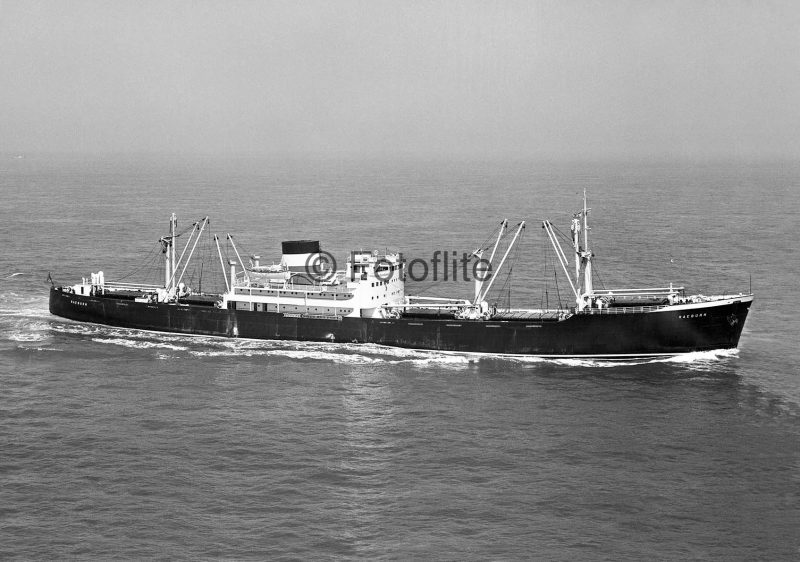
Romney and Raeburn had two complete shelterdecks plus a part third deck forward of the machinery spaces. Romney had a grain capacity in her five holds of 636,734 cubic feet and a bale cubic capacity of 575,000 cubic feet, while the figures for Raeburn were 634,930 grain and 567,890 bale. Romney carried eleven first class passengers on her Bridge Deck, while Raeburn carried only ten first class passengers. The funnels of both vessels, particularly that of Romney, were really too large and they gave the effect of making the pair look like smaller cargo-liners than they really were, the gross tonnage of Romney was 8,237 while that of Raeburn was 8,312. The forward Dining Room and the passenger staterooms on Bridge Deck, and the galley on Upper Deck, and other rooms were all equipped with fire fighting equipment supplied by Walter Kidde & Co. Ltd. at their Lux Works at Northolt in Middlesex. Raeburn was fitted out in the Musgrave Channel at Belfast, the later site of the big Harland & Wolff Ltd. building dock of 1969 served by its twin yellow ‘Goliath’ cranes.
Raphael and Ronsard
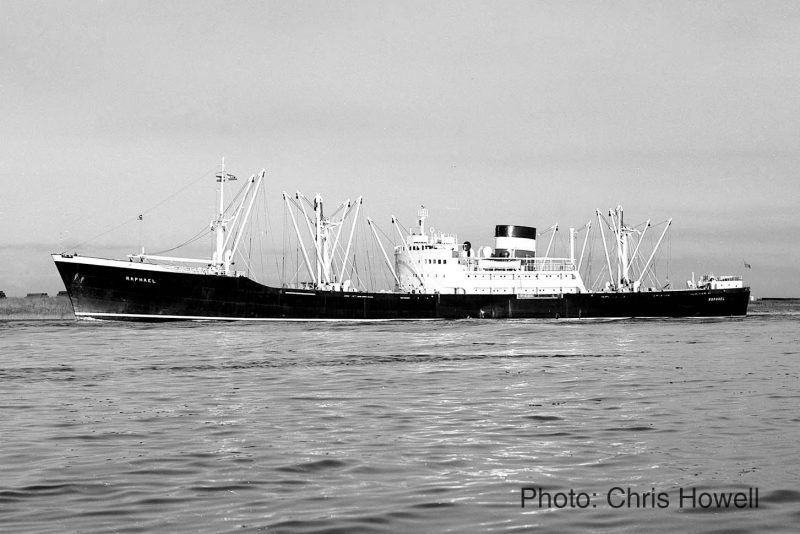
The specification for these two sisters handed to the draughtsmen of the South Dock shipyard of Bartram & Sons at Sunderland was for two good quality cargo-liners. Minimum scantlings were to be used, and the upper deck plating was to be of specially approved steel, and the upper hatch corners were to be specially drawn with separate plans submitted for approval. The six cylinder North East Marine – Doxford diesel of 7,500 bhp gave both sisters a service speed of 17.5 knots, with Raphael the faster of the two as she was fitted with scavenging arrangements. The weight of the machinery including auxiliaries but excluding the propeller was 830 tonnes to give a full load displacement of 14,840 tonnes and a trials speed over the Newbiggin Measured Mile that was in excess of the required service speed. Four edible oil tanks were included under number four hold, with two on each side of the shaft tunnel spaces. There were oil fuel tanks to port and starboard of the engine room and in the cellular double bottom. The deck layouts of these two sisters are now described:-Navigating Bridge Deck had the central wheelhouse with the Radio Room and Radio Officer’s cabin to port and the chartroom to starboard.
Boat Deck was only 25 feet wide and had the Captain’s Dayroom forward on the port side with his bedroom aft, with the Passenger Lounge forward on the starboard side with the Owner’s Stateroom and bar aft of this lounge.
Bridge Deck had the central forward feature of the Dining Room for passengers and officers, with staterooms for four passengers to port and starboard. Moving aft on the port side was the pantry, Chief Engineer’s dayroom and bedroom plus cabins for the Second, Third, Fourth, Fifth and Sixth Engineers. Moving aft on the starboard side was a further passenger stateroom for two passengers, Chief Steward’s Room, Chief Officer’s Room, and cabins for the Second and Third Officers plus a room for three cadets and their messroom aft.
Upper Deck forward had cabins for the Second Steward, Bosun, Carpenter, Donkeyman and two seamen. Moving aft on the port side was the galley, Steward’s Mess, Chief Cook, and cabins for six stewards and six greasers. Moving aft on the starboard side was the Seamen’s Mess, cabins for twelve seamen and the Ship’s Hospital aft. The main electrical switchboard was located ‘midships forward of the funnel casing and next to the Drying Room.
Second Deck below Upper Deck held the Bonded Stores and storerooms for beer, flour, bulk food, vegetables, meat, fish, and other foods as well as the refrigerating machinery and the Carbon Dioxide Room.
The grain cubic capacity was 606,800 cubic feet and the bale was 542,290 cubic feet, with a deadweight of 10,250 tonnes and a gross tonnage of 7,971. They were fitted with two ‘tween decks in numbers one, two and three holds, and a single ‘tween deck in numbers four and five holds. Ronsard had windows on her Bridge Deck cabins, instead of portholes on Raphael, and as she was completed four years later she had a slightly different Doxford diesel, which could not be pushed beyond its limits. Raphael remained as the fastest ship in the Lamport & Holt fleet for 23 years until she was sold off to Cypriot owners in 1976.
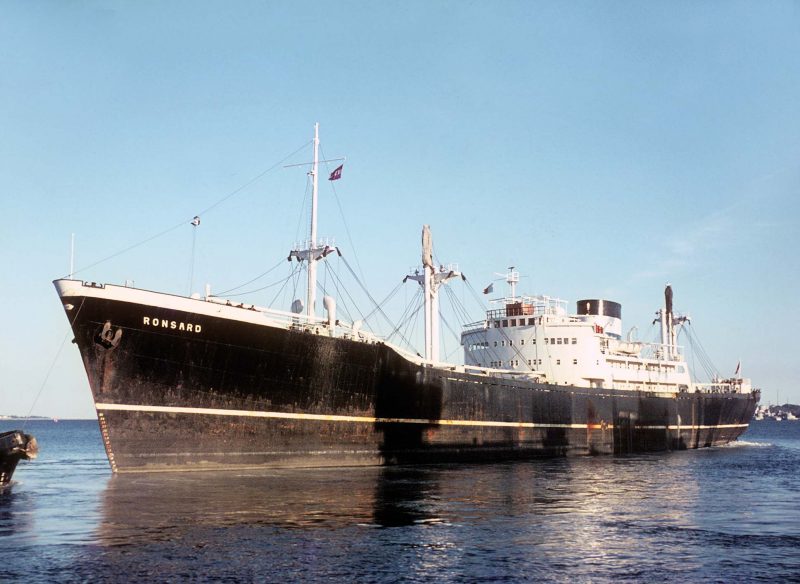

The ‘R’ Class In Service
After only seven months in service, Raeburn grounded on the Monkstone Rocks off Cardiff on 3rd September 1953, and was firmly stuck until the old salvage steamer Ranger of 409 grt, built in 1880 by the Elder yard on the Clyde, was contracted from the Mersey Docks and Harbour Board to refloat her. The severe bottom damage took a year to repair at her builders yard of Harland & Wolff Ltd. at Belfast. All four ‘R’ class were in service in Lamport & Holt funnel colours to the East Coast of South America during 1957/58, but Raeburn was transferred to Blue Star Line on bareboat charter later in 1958 and renamed Colorado Star. She was placed on the Pacific North American service after the Donaldson Line route was taken over.
Colorado Star then sailed from Glasgow and Liverpool to transit the Panama Canal and sail up the west coast of Mexico to Long Beach, San Francisco, Redwood City, Portland (Oregon), Seattle and Vancouver (BC), the terminus of the service. In 1967, she was modified by the Cammell Laird yard at Birkenhead to carry two rows of twenty foot Lamport & Holt containers along each side of her deck, and below decks the hatches were squared off to carry palletised cargo. Additionally, the derrick topping lifts were fitted with electric winches. The red and white Lamport and Holt houseflag was also flown by Romney in the Canadian ports of Montreal, Quebec and Halifax during six round voyages in 1957/58 down to Brazil and Argentina. Romney sailed from Halifax in December 1958 on the last of these voyages with general cargo and cattle in pens, arriving in Buenos Aires in early April 1959.
The ‘R’ class took three months on a round voyage to Brazilian, Uruguayan and Argentinean ports. Many of the seamen in the crew were young men aged between 16 and 25 years of age, with the Bosun not much older. Outward cargo consisted of general cargo of all types including drums of paint, machinery, steel products, chemicals, bagged cement and malt, cased whisky, and any other miscellaneous manufactured items that were not readily available in the 1950s in South America. Homeward cargo did not include meat and fruit as the ‘R’ class were unrefrigerated, but did include cereals (wheat, flour, maize, linseed, oats, etc), wool, groundnuts, sugar, cotton, cocoa, tinned corned beef, timber, bales of silk and rayon, and lots of coffee as this amounted to 90% of Brazilian produce at this time.
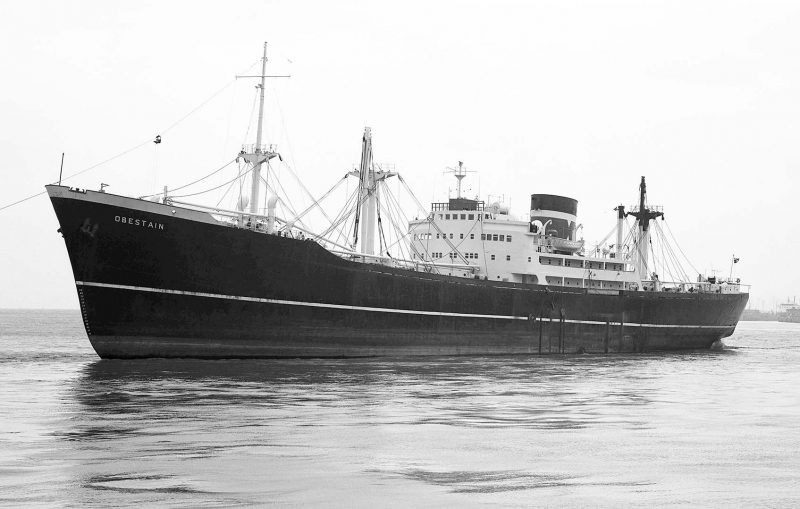
The Plate estuary is deceptive when viewed on a map, as it is impeded by banks of sand with shifting channels unfit for navigation by any deep sea vessel. West of Montevideo, the approach to Buenos Aires is one hundred miles or more by a relatively narrow channel dredged to around thirty feet. Twenty miles below Buenos Aires lies La Plata and its outport of Puerto Santiago with a moderate tidal range to increase the minimum depths of water. The produce of Argentina is one third exported through Buenos Aires, 25% through Rosario, 10% through Bahia Blanca to the south, while the remainder is divided among the smaller river ports such as Concepcion del Uruguay. The loading of grain at Rosario, San Nicolas and Santa Fe on the Parana river was usually quickly completed, but the depth to which a vessel was loaded was critical as there were difficult shallow stretches of the river to negotiate when moving downstream.
Santos in southern Brazil is reached by a five mile long channel in its estuary with a minimum depth of thirty feet. The harbour is formed by a river curving around the city, and vessels in the anchorage were frequently attacked by robbers keen to relieve the crew of their money and possessions. There was no dry dock in Santos if a vessel arrived in trouble to load coffee, which arrived by train on many profitable railway lines from the interior. It could be said that Santos was built on the profits of coffee, but the port also exported hides, chilled and frozen meat, oranges, bananas and other fruit. The ‘R’ class always called at Santos, while other Brazilian ports of call were usually made at Rio Grande do Sul, Itaijai, Paranagua, Rio de Janeiro with its prominent Sugar Loaf and Corcovado mountains when approached by sea, Salvador (Bahia) and Recife (Pernambuco).
Colorado Star, the former Raeburn, did not return to the East coast of South America trades of Lamport and Holt until 1977 under the name of Roland, as she had transferred to Austasia Line in 1972 for their Far Eastern trades under the name of Mahsuri. Two other vessels of around 10,000 dwt with ‘R’ names had been used by Lamport and Holt during the intervening period. One was the similar Canadian Star of 9,500 dwt, built for Blue Star Line in 1957 by the Caledon yard at Dundee, and powered by a six cylinder two stroke single acting Scott-Doxford diesel of 8,000 bhp to give a service speed of sixteen knots. She was a shelterdecker with a cubic grain capacity of 567,890 cubic feet, and could carry a small amount of 16,080 cubic feet of refrigerated cargo. She was renamed as Raeburn in 1972 in Lamport and Holt colours and served for seven years until sold off to Cypriot owners. The other ‘R’ class sized vessel was dissimilar to the main ‘R’ class as she had been laid down in 1949 as Bolton Castle for Mollers Trust Ltd. with James Chambers & Co. Ltd. of Liverpool as managers with no poop or streamlining of design. She had been completed in April 1950 as Dunedin Star for Blue Star Line, and served for eighteen years until transferred to Lamport and Holt in 1968 under the name of Roland of 11,210 dwt. She had five holds with a large cubic grain capacity of 708,000 cubic feet, and was powered by three double reduction geared turbines fed with steam from two watertight boilers to give a service speed of fourteen knots, and served Lamport and Holt for seven years until sold to Cypriot owners in 1975.
Thus in 1973, there were five ‘R’ class Lamport and Holt vessels of around 10,000 dwt in the fleet maintaining a monthly service to Brazil and the Plate, with Romney, Raphael and Ronsard, the subjects of this article, and Roland, the former Dunedin Star, and Raeburn, the former Canadian Star. There were two further smaller vessels with ‘R’ names in the post-war Lamport and Holt fleet, the sisters Rubens/Rossini and Rossetti of 7,250 dwt, which in reality were four hold versions of the larger ‘R’ class. They had been built by the Southwick yard of William Pickersgill & Sons Ltd. in Sunderland in 1952 and 1956 respectively on dimensions of 436 feet length by 57 feet beam and depth of 24 feet. They were powered by five cylinder Richardsons, Westgarth or North East Marine-Doxford diesels of 5,500 bhp to give a service speed of fifteen knots. They had spent a good deal of their careers on the Amazon trade of Booth Line, also a Vestey Group member since 1946. They had the same sheer of hull and length of fo’c’stle of around ninety feet with no poop as the larger four members of the ‘R’ class, and from a great distance could be mistaken for them.
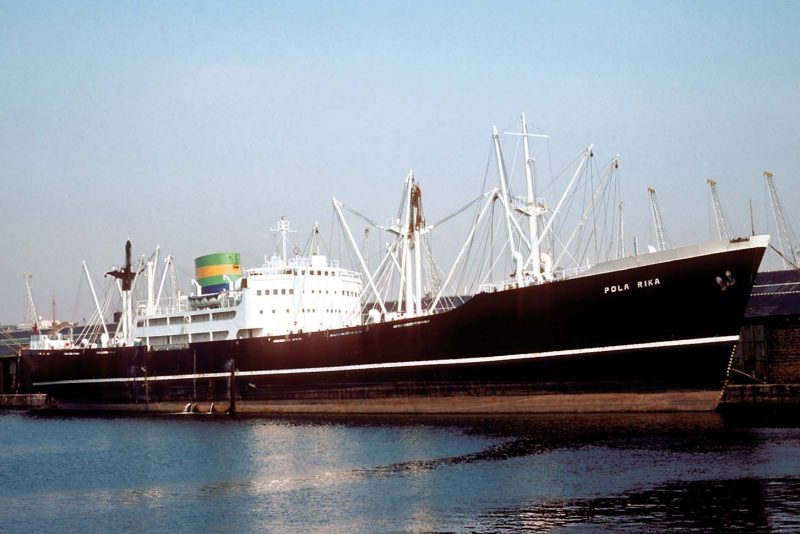
‘R’ Class Finale
Raphael had been sold in June 1976 to Cypriot owners and renamed Pola Rika, and sailed on until she arrived for scrapping at Gijon in Spain on 30th May 1979. At the beginning of 1978, the fleet of four ‘R’ class vessels, Romney, Roland (ex Raeburn), Ronsard, and Raeburn (ex Canadian Star), were still busy on their dedicated voyages to the east coast of South America. Romney had made 99 round voyages by September of that year as flagship of the fleet when she was sold for scrapping to Shipbreaking Industries of Faslane. She had made an average of four voyages per year for 26 years to the Plate, a very good record, and voyage number one hundred was the short hop from Liverpool to Faslane, arriving there on 2nd October. She was joined three days later alongside at Faslane by her near sister Roland, the former Raeburn.
This left Ronsard and Raeburn (ex Canadian Star) in service, with Raeburn en route from Santos to Liverpool at the time of the demise of Romney and Roland (ex Raeburn). Ronsard had sailed from the Tees on 23rd September 1978 for Santos, and this occasional loading of the ‘R’ class on the east coast in the Tees had continued throughout the 1970s decade after I had seen Romney loading in Middlesbrough Dock in September 1971. Raeburn (ex Canadian Star) was sold to Cypriot owners in early 1979 and renamed Braeburn, and arrived for scrapping at Kaohsiung on 9th May of that year. Ronsard followed a year later in late 1980 to Panamanian owners for one or more ‘spot’ charter voyages loaded with scrap under the name of Obestein. She finally arrived at Kaohsiung from Bangkok for scrapping in August 1981 as the last member of the ‘R’ class still afloat.
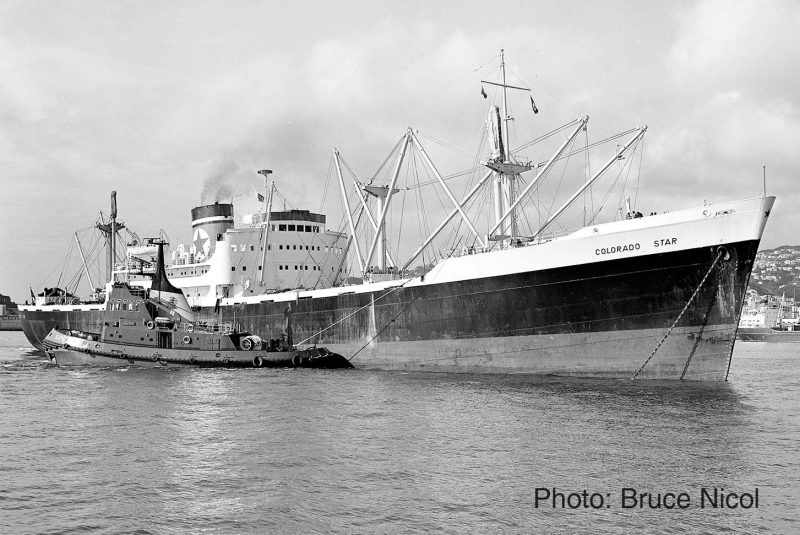
Postscript
The four ‘R’ class of Romney, Raeburn, Raphael and Ronsard were very good looking cargo-liners, especially when fully loaded down to their marks. The large funnel of Romney with her prominent blue and white bands and black top may have been a little large, but her white ‘midships structure and white masts and derricks shone in the bright sunlight of Brazilian and Argentinean ports. Their names were painted in white on both the port and starboard quarters instead of in the middle of their stern, and the white band around their black hulls at their Plimsoll marks gave them an even better handsome appearance. All who saw them in service between 1952 and 1980 were impressed by their profile, features and form as very good quality British cargo-liners.
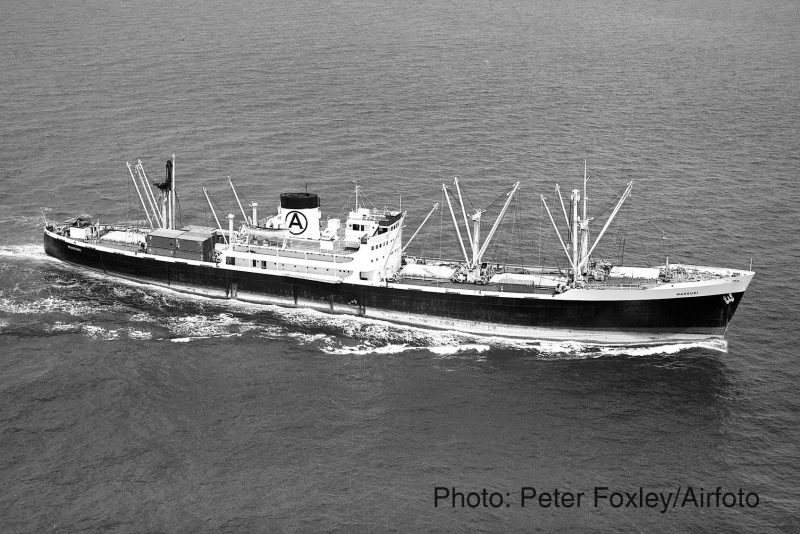
The name of Romney was revived in October 1983 by the purchase of the ‘Fish’ class cargo-liner Ruddbank of 18,500 dwt from Bank Line. She was purchased at Rotterdam for the then Lamport and Holt container service to South America. She served for five voyages from Avonmouth to the Falklands, Montevideo and Brazilian ports to Liverpool for the BRISA pool (British South America Line) and BHLR pool (Blue Star Line, Houlders, Lamport and Holt and Royal Mail). She was renamed Lairg in 1986 but still under Vestey ownership, for a west coast U.S.A. and Canada service to the South Pacific. She was renamed Napier Star by Blue Star Management in 1989 and sold off in 1991 and renamed Tamapatcharee with Andrew Weir retained as managers. The red and white Lamport and Holt houseflag was pulled down for the last time in 1991 when their last container ship Churchill was transferred to Blue Star livery and renamed Argentina Star. The name of Lamport and Holt then disappeared from the list of Liverpool shipowners after an illustrious 146 years.
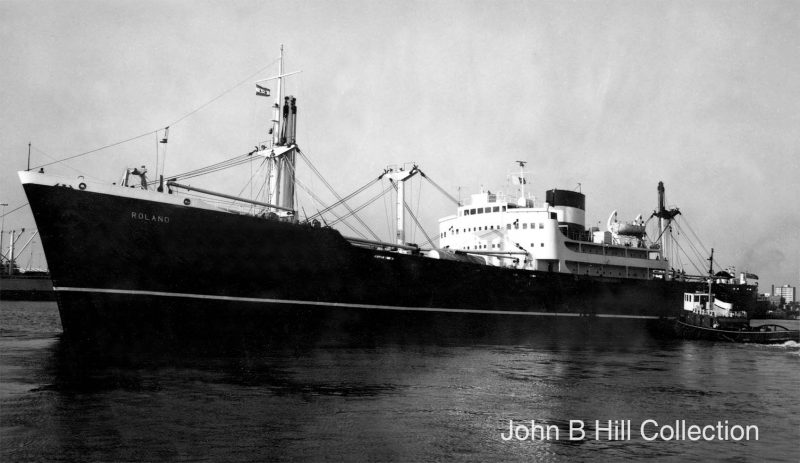





Comments
Sorry, comments are closed for this item